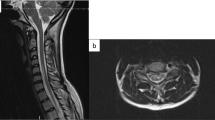Abstract
Introduction
Spinal cord infarction is extremely rare in childhood and can result from a wide range of causes. Fibrocartilaginous embolism can give rise to spinal stroke and mimic non-vascular disease such as acute transverse myelitis.
Case
We report two children who suffered an asymmetrical spinal cord infarction due to fibrocartilaginous embolism. The clinical presentation, radiological findings, and pathophysiology of fibrocartilaginous embolism are described. Each patient demonstrated marked clinical improvement after receiving extensive physical therapy and rehabilitation. One child demonstrated complete clinical recovery. The other had persistent asymmetrical foot weakness and distal sensory deficits.
Conclusion
We outline the key clinical and radiographic features that enable spinal cord infarction to be differentiated from transverse myelitis. Prognosis depends on many factors such as extent and type of injury, level of the cord affected, and age at the time of spinal cord infarction.


Similar content being viewed by others
References
Bracken MB, Shepard MJ, Collins WF, Holford TR, Baskin DS, Eisenberg HM, Flamm E, Leo-Summers L, Maroon JC, Marshal LF, Perot PL, Piepmeier J, Sonntag VK, Wagner FC, Wilberger JL, Winn HR, Young W (1992) Methylprednisolone or naloxone treatment after acute spinal cord injury: 1-year follow-up data. Results of the second National Acute Spinal Cord Injury Study. J Neurosurg 76:23–31
Davis GA, Klug GL (2000) Acute-onset nontraumatic paraplegia in childhood: fibrocartilaginous embolism or acute myelitis? Childs Nerv Syst 16:551–554
Franceschini M, Cerrel BH, Lauretani F, Agosti M, Pagliacci MC (2011) Age influences rehabilitative outcomes in patients with spinal cord injury (SCI). Aging Clin Exp Res 23:202–208
Han JJ, Massagli TL, Jaffe KM (2004) Fibrocartilaginous embolism—an uncommon cause of spinal cord infarction: a case report and review of the literature. Arch Phys Med Rehabil 85:153–157
Kolominsky-Rabas PL, Weber M, Gefeller O, Neundoerfer B, Heuschmann PU (2001) Epidemiology of ischemic stroke subtypes according to TOAST criteria: incidence, recurrence, and long-term survival in ischemic stroke subtypes: a population-based study. Stroke 32:2735–2740
Moffett KS, Berkowitz FE (1997) Quadriplegia complicating Escherichia coli meningitis in a newborn infant: case report and review of 22 cases of spinal cord dysfunction in patients with acute bacterial meningitis. Clin Infect Dis 25:211–214
Naiman JL, Donohue WL, Prichard JS (1961) Fatal nucleus pulposus embolism of spinal cord after trauma. Neurology 11:83–87
Nance JR, Golomb MR (2007) Ischemic spinal cord infarction in children without vertebral fracture. Pediatr Neurol 36:209–216
Sandson TA, Friedman JH (1989) Spinal cord infarction. Report of 8 cases and review of the literature. Medicine (Baltimore) 68:282–292
Sofronas M, Ichord RN, Fullerton HJ, Lynch JK, Massicotte MP, Willan AR, deVeber G (2006) Pediatric stroke initiatives and preliminary studies: what is known and what is needed? Pediatr Neurol 34:439–445
Tosi L, Rigoli G, Beltramello A (1996) Fibrocartilaginous embolism of the spinal cord: a clinical and pathogenetic reconsideration. J Neurol Neurosurg Psychiatry 60:55–60
Transverse Myelitis Consortium Working Group (2002) Proposed diagnostic criteria and nosology of acute transverse myelitis. Neurology 59:499–505
Wilmshurst JM, Walker MC, Pohl KR (1999) Rapid onset transverse myelitis in adolescence: implications for pathogenesis and prognosis. Arch Dis Child 80:137–142
Yousef OM, Appenzeller P, Kornfeld M (1998) Fibrocartilagenous embolism: an unusual cause of spinal cord infarction. Am J Forensic Med Pathol 19:395–399
Author information
Authors and Affiliations
Corresponding author
Rights and permissions
About this article
Cite this article
Rengarajan, B., Venkateswaran, S. & McMillan, H.J. Acute asymmetrical spinal infarct secondary to fibrocartilaginous embolism. Childs Nerv Syst 31, 487–491 (2015). https://doi.org/10.1007/s00381-014-2562-9
Received:
Accepted:
Published:
Issue Date:
DOI: https://doi.org/10.1007/s00381-014-2562-9




